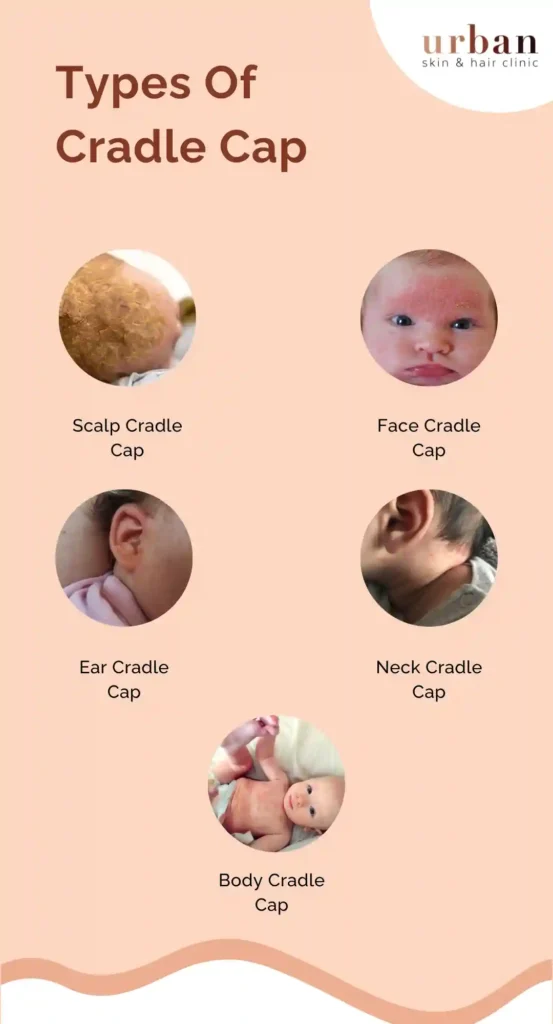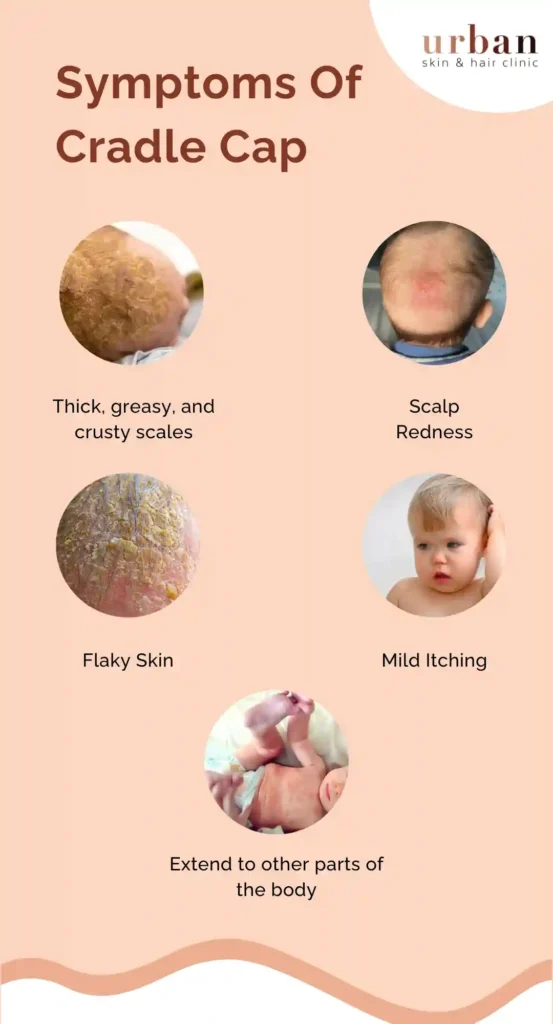
What Is Cradle Cap?
Cradle cap, also known as infantile seborrheic dermatitis, is a common skin condition that often affects infants. It appears as crusty or oily, scaly patches on a baby’s scalp. The exact cause of cradle cap is not fully understood, but it is believed to be related to the overproduction of oil (sebum) in the sebaceous glands of the skin and the presence of a yeast called Malassezia.
The condition is harmless and usually not itchy or painful for the baby, but it can be unsightly for parents. Cradle cap typically presents within the first few months of a baby’s life and may last for several weeks or months. It can sometimes extend to other areas of the body, such as the face, ears, neck, and diaper area.
What are the Types of Cradle Cap?
Cradle cap, also known as infantile seborrheic dermatitis, can present in different forms or locations on the baby’s body.
- Scalp Cradle Cap: This is the most common type of cradle cap and appears as thick, yellow or white, greasy, and scaly patches on the baby’s scalp. It is often mistaken for dandruff, but unlike dandruff, it tends to be more adherent and can cover a larger area.
- Face Cradle Cap: Some babies may develop cradle cap on their face, particularly around the eyebrows, eyelids, nose, and cheeks. The affected areas may have similar greasy, yellowish scales as seen on the scalp.
- Ear Cradle Cap: Cradle cap can also affect the area behind the baby’s ears, leading to crusty and scaly patches.
- Neck Cradle Cap: The folds of the baby’s neck may also be affected by cradle cap, resulting in the presence of greasy scales.
- Body Cradle Cap: Though less common, cradle cap can extend beyond the head and appear on the baby’s torso, particularly in the chest and diaper area. It’s important to note that cradle cap is usually not a cause for concern, and it typically improves on its own over time.

What are the causes Of Cradle Cap
The exact cause of cradle cap is not fully understood, but it is believed to be a combination of factors contributing to the condition. Some of the primary causes and contributing factors of cradle cap include:
- Overactive Sebaceous Glands: In newborns and infants, the sebaceous glands, which produce the skin’s natural oils (sebum), can be overly active. This excessive production of sebum can lead to the formation of greasy and oily scales on the baby’s scalp.
- Hormonal Influence: Hormones passed from the mother to the baby during pregnancy may play a role in stimulating the sebaceous glands, contributing to cradle cap development.
- Fungal Involvement: The presence of a yeast called Malassezia on the skin has been associated with cradle cap. Malassezia is a type of fungus that normally lives on the skin, but in some cases, it can grow more abundantly and contribute to the development of the condition.
- Immature Skin: The skin of newborns and infants is still developing and may not efficiently shed dead skin cells, leading to the accumulation of scales and flakes.
- Genetics: There might be a genetic predisposition for some babies to develop cradle cap.
- Environmental Factors: Certain environmental factors, such as weather conditions, heat, and humidity, might play a role in exacerbating cradle cap.
It’s important to note that cradle cap is not caused by poor hygiene, allergies, or an infection, and it is not contagious.
If your baby is suffering from Cradle Cap skin problem it’s better to book an appointment and get treated.
Now you know what are the causes it’s important to understand the symptoms of cradle cap,
signs & Symptoms Of Cradle Cap
Cradle cap presents with specific symptoms that are usually easy to identify. Here are the common symptoms of cradle cap:
- Thick, Greasy, Yellowish or White Scales: The primary characteristic of cradle cap is the presence of thick, greasy, and crusty scales on the baby’s scalp. These scales may vary in color, ranging from yellowish to white.
- Scalp Redness: The affected areas of the scalp may appear slightly red or inflamed around the edges of the scales.
- Flaky Skin: As the scales start to loosen, they may flake off, resembling dandruff. The flakes might fall onto the baby’s shoulders or clothing.
- Oily Skin: The skin under the scales may appear oily or greasy due to the overactive sebaceous glands.
- Mild Itching: Cradle cap is generally not itchy for the baby, but in some cases, there might be mild itching or discomfort.
- Presence in Other Areas: In some cases, cradle cap can extend to other parts of the body, such as the face (around eyebrows, eyelids, and cheeks), ears, neck, and diaper area. The scales in these areas may have a similar appearance to those on the scalp.
- Persistent or Recurrent: Cradle cap may persist for several weeks or months, gradually improving and resolving over time.
- Absence of Other Symptoms: Generally, cradle cap is a benign condition and doesn’t cause fever, pain, or other significant symptoms. If there are other concerning symptoms, it might be due to another underlying condition and should be evaluated by a healthcare professional.
It’s essential to note that cradle cap is a common and harmless condition in infants, and it does not pose any serious health risks. It usually resolves on its own as the baby grows and their skin matures. Simple measures like gentle cleansing and moisturizing can help manage the symptoms effect.

Treatment For Cradle Cap
Cradle cap typically does not require medical treatment as it is a harmless and self-limiting condition that tends to improve on its own as the baby’s skin matures. However, some simple home care measures can help manage the symptoms and promote the natural resolution of cradle cap. Here are some treatment approaches:
Regularly washing your baby’s scalp with a mild baby shampoo can help remove excess oil, dirt, and scales. Gently massage the scalp with your fingers while shampooing, and then rinse thoroughly. Avoid using adult-strength shampoos or harsh soaps, as they may irritate the baby’s delicate skin.
After shampooing, use a soft baby brush or a fine-tooth comb to gently loosen and remove the scales. Be very gentle to avoid causing any discomfort or damaging the baby’s delicate skin
Applying a small amount of baby oil, mineral oil, or petroleum jelly to the affected areas can help soften the scales, making them easier to remove during bathing. Leave the oil on for a short period before gently brushing the scales off.
Some parents find coconut oil beneficial in treating cradle cap. Apply a thin layer of coconut oil to the affected areas, leave it on for a few minutes, and then gently brush away the scales.
the cradle cap is severe or persists, you can try washing the baby’s scalp more frequently (but still gently) to help keep the area clean.
In dry climates or during the winter when indoor heating can cause dry air, using a humidifier in the baby’s room can help maintain the skin’s moisture and reduce the severity of cradle cap.
If these home care measures do not lead to improvement or if the cradle cap becomes severe or spreads to other areas of the body, it’s best to consult a pediatrician or dermatologist. Visit Urban Skin & Hair clinic today or contact us and get help your baby to get rid from Cradle cap.


